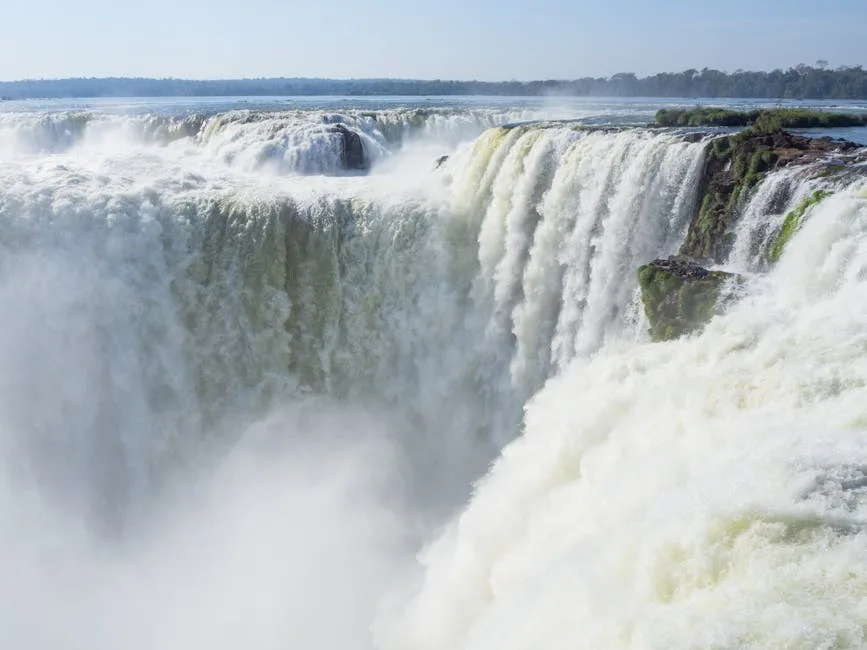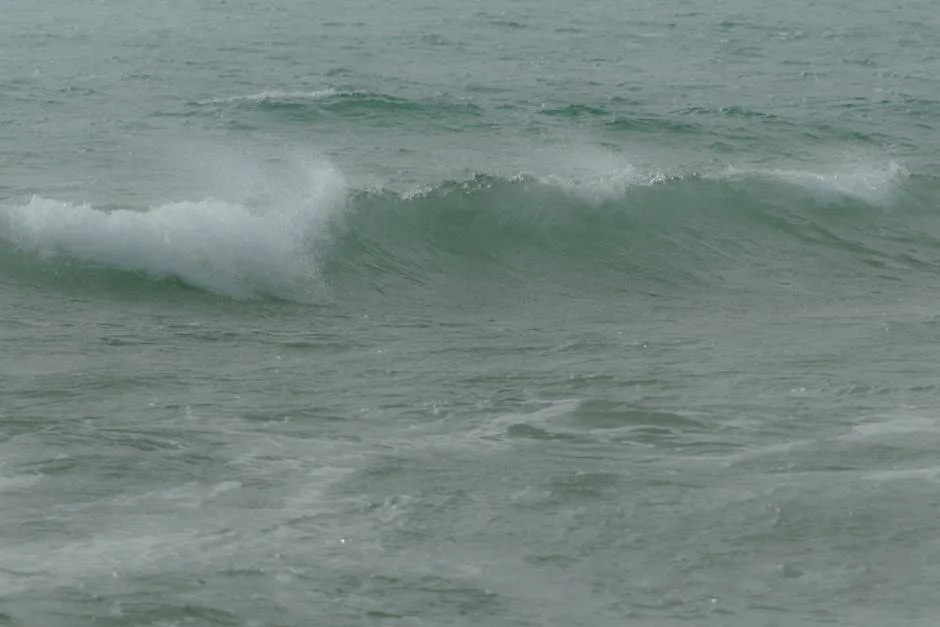- A Symphony of Water and Wonder
- Choosing Your View: The Great Iguazu Debate (Brazil vs. Argentina)
- The Brazilian Side: The Grand Panorama
- The Argentinian Side: Up Close and Personal
- When is the Best Time to Witness the Spectacle?
- Your Gateway to the Falls: Getting In and Getting Around
- Adventures That Go Beyond the Boardwalks
- The Gran Aventura Boat Trip
- A Bird's-Eye View: Helicopter Tours
- Practical Tips for a Flawless Iguazu Trip
A Symphony of Water and Wonder
Imagine a sound. Not just any sound, but a deep, soul-shaking roar that you feel in your chest long before you see its source. It’s the sound of the entire Iguazu River plunging over a series of cliffs, a constant, thunderous applause from nature itself. When former First Lady Eleanor Roosevelt first laid eyes on this spectacle, she reportedly whispered, “Poor Niagara!” And honestly, you get it. Iguazu Falls isn’t just a waterfall; it’s a sprawling, breathtaking collection of 275 individual cascades that stretch for nearly two miles along the border of brazil and Argentina. It’s a place that recalibrates your sense of scale and leaves you utterly, profoundly humbled.
Nestled within a lush, subtropical rainforest, a UNESCO World Heritage site, Iguazu (or Iguaçu in Portuguese) means “Big Water” in the native Guarani language—a contender for the world’s greatest understatement. The sheer volume of water, especially during the rainy season, is staggering. It’s a raw, untamable display of Earth’s power, a place where rainbows seem to be a permanent fixture, arcing through the constant mist. This isn’t just a sight to be seen; it’s an experience to be fully absorbed through every one of your senses.
Choosing Your View: The Great Iguazu Debate (Brazil vs. Argentina)
The most common question travelers ask is, “Which side is better?” The simple answer is: they’re not better, they’re different. Think of it like a magnificent sculpture; you need to see it from a distance to appreciate its full form and then get up close to see the intricate details. If you have the time, visiting both the Brazilian and Argentinian sides is not just recommended, it’s essential for the complete Iguazu experience.
The Brazilian Side: The Grand Panorama
The Parque Nacional do Iguaçu in Brazil offers the postcard view. As the saying goes, Argentina has the falls, but Brazil has the view. A single, well-maintained walkway snakes along the canyon, providing sweeping, cinematic vistas of the Argentinian side. Every turn reveals a more stunning panorama than the last. You’ll see the San Martin Island and the countless falls cascading around it, giving you a true sense of the system’s immense scale.
The climax of the Brazilian side is the walkway that extends out over the water, leading you to a viewpoint near the main event: the Devil’s Throat. While you don’t get as close as you do in Argentina, you feel the spray and hear the deafening roar as you gaze upon the heart of the falls. It’s the perfect introduction, the wide-angle shot that sets the stage for what’s to come.
The Argentinian Side: Up Close and Personal
If Brazil is the movie, Argentina’s Parque Nacional Iguazú is the immersive, 4D experience. This side is all about getting you right into the action. It’s a much larger park with a network of trails and circuits that allow you to explore the falls from above, below, and right at their edge. Prepare to get a little wet and a lot amazed.
The park is cleverly divided into three main circuits:
- The Upper Circuit (Circuito Superior): This series of catwalks takes you along the top of the waterfalls. You’ll walk directly over the precipice of several cascades, peering down into the churning water below. It’s a dizzying and exhilarating perspective that highlights the sheer power just inches beneath your feet.
- The Lower Circuit (Circuito Inferior): This path winds its way down to the base of several falls. Here, you can feel the spray on your face and witness the true force as the water crashes into the river below. It’s a more intimate experience, surrounded by the lush jungle and the thunderous noise.
- The Devil’s Throat (Garganta del Diablo): This is the showstopper. To get here, you’ll take a small, open-air train through the jungle to a station, followed by a serene walk along a kilometer-long metal catwalk built over the calm, wide upper Iguazu River. The tranquility of this walk makes the final reveal all the more shocking. The walkway ends abruptly at the edge of the abyss—a massive, U-shaped chasm where nearly half of the river’s entire flow converges and plummets 262 feet. The roar is deafening, the spray is blinding, and the raw, violent power is something you will never, ever forget.
When is the Best Time to Witness the Spectacle?
There’s really no bad time to visit Iguazu, but the experience changes with the seasons.
- December to March (Summer/Rainy Season): This is when the falls are at their most powerful and dramatic. The water volume is immense, creating a truly thunderous spectacle. The trade-offs? It’s hot, humid, and often rainy. Crowds are at their peak due to South American holidays, and some trails on the Argentinian side can occasionally close due to high water levels.
- April to June (Fall/Dryer Season): Many consider this the sweet spot. The weather is more pleasant, the crowds have thinned out, and while the water volume is lower, the falls are still incredibly impressive. In fact, with less water and mist, you can often see the rock faces and individual cascades more clearly.
- July to September (Winter): This is the driest and coolest time of year. The falls will be at their least voluminous, but you’ll be rewarded with clear blue skies and comfortable temperatures for walking.
Your Gateway to the Falls: Getting In and Getting Around
The falls are flanked by two gateway cities: Foz do Iguaçu in Brazil and Puerto Iguazú in Argentina. Both have their own airports with good connections—Foz do Iguaçu (IGU) and Cataratas del Iguazú (IGR). Moving between the two towns (and thus, the two sides of the falls) is straightforward via public bus, taxi, or a pre-booked transfer. Just remember that you are crossing an international border, so have your passport handy and be sure to check visa requirements for your nationality for both Brazil and Argentina well in advance.
Adventures That Go Beyond the Boardwalks
While the walkways provide incredible views, a few extra adventures can elevate your trip from great to unforgettable.
The Gran Aventura Boat Trip
Offered on the Argentinian side, this is an absolute must for thrill-seekers. After a truck ride through the jungle, you’ll board a high-speed Zodiac boat that drives directly into the spray of the falls. You will get completely, utterly soaked—it’s like a baptism by waterfall. They give you a dry bag for your belongings, but wear clothes you don’t mind getting drenched. It’s a wild, exhilarating ride that gives you a mouse’s-eye view of these giants.

A Bird’s-Eye View: Helicopter Tours
For a truly epic perspective, helicopter tours are available from the Brazilian side. Soaring above the vast complex of waterfalls gives you a unique appreciation for the sheer scale and geography of the area that you simply can’t grasp from the ground.
Practical Tips for a Flawless Iguazu Trip
A little preparation goes a long way in making your visit smooth and enjoyable.
- Dress the Part: Wear lightweight, quick-drying clothes. Comfortable, sturdy walking shoes with good grip are essential, as the catwalks can get slippery.
- Stay Dry (or Try To): A lightweight rain jacket or poncho is a good idea year-round. A waterproof phone case or a Ziploc bag is crucial for protecting your electronics from the constant mist.
- Pace Yourself: The parks are huge. Plan to spend a full day on the Argentinian side and at least half a day on the Brazilian side. Start early to beat the crowds and the midday heat.
- Sun Protection: The sun can be intense. Bring sunscreen, a hat, and sunglasses.
- Meet the Coatis: You will undoubtedly encounter bands of coatis, raccoon-like creatures that are very cute and very bold. Do NOT feed them. They can be aggressive, and feeding them is bad for their health and encourages problematic behavior. Admire them from a distance.
Visiting Iguazu Falls is more than just ticking an item off a bucket list. It’s a visceral encounter with the planet’s raw energy. It’s the feeling of the mist on your skin, the thunder in your ears, and the breathtaking sight of a river seemingly falling from the sky. It’s a place that reminds you of how powerful, and how beautiful, our world truly is.






